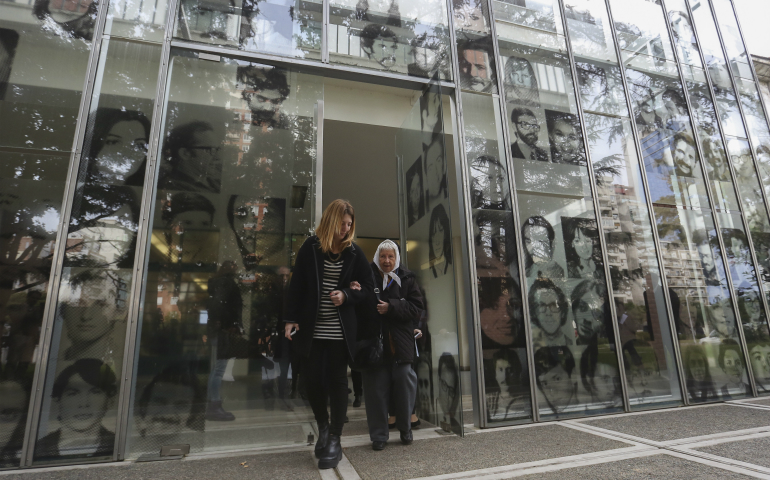
A representative of the organization Mothers of the Plaza de Mayo, right, attends an event at the Ex-ESMA Memorial in Buenos Aires, Argentina, May 19, 2016. The biggest torture center during the last Argentinian dictatorship (1976-1983) has been signaled and protected with the United Nations' Blue Shield. (Newscom/David Fernandez, EFE)
In recent years, Argentina has been recognized for its work bringing to justice perpetrators of state crimes during its period of military dictatorship, but a May 3 Supreme Court ruling that opens the door for early release of those convicted of crimes against humanity has some here wondering if the nation is shifting course and denying its past.*
Reports and human rights advocates have long put the number killed during that time at 30,000, and in recent years more than 700 persons, mostly military, have been convicted and sentenced to prison. The recent court decision, however, has condemned criminals scrambling for early release.
The decision also comes in the wake of comments last year by President Mauricio Macri that he "didn't know" how many died in the paroxysm of state violence that gripped the nation during a right-wing military dictatorship from 1976 to 1983.
But Macri said the number may be as low as 9,000. Earlier, Buenos Aires City Culture Minister Darío Lopérfido stirred controversy when he said the "real" number was close to 8,000. Juan Gomez Centurion, a former soldier nominated by Macri to be head of Argentine Customs, spoke of the forced disappearances saying "8,000 truths are not the same thing as 22,000 lies. There was no systematic plan for the disappearance of people."
Such comments and the court decision have Argentine activists and relatives of the disappeared worried that denial about the horrific period is officially taking root.
In October, at the express direction of Pope Francis (who was a Jesuit superior in Argentina during the dictatorship), the Argentine Episcopal Conference, the Vatican embassy in Buenos Aires and the Vatican Secretariat of State announced they would make archives from the dictatorship era available to families of the disappeared, and later, to academics.
"Reconciliation in the context of a culture of encounter" was one of the topics when the Argentine Episcopal Conference met in plenary assembly May 2-6. One day during the assembly of more than 100 clerics, bishops heard testimony from a number of witnesses, including one whose son was disappeared by the military, the sister of three victims of the military, and a man whose father was murdered by leftist guerrillas. Listening to the witnesses during the plenary meeting was part of the wider process of "reflection" on the era, an episcopal source told local press. "We must converse about that historic moment with a view toward reconciliation," said the source.
Nevertheless, for some, the appearance of aggrieved from "both sides" of the dictatorship appeared to draw a false equivalency of crimes by the state and crimes by the opposition, whose armed elements had been virtually wiped out when the military began its reign of terror.
Having the hierarchy of the Argentine church, which notably supported the military during the worst of the state violence, call for "reconciliation" seemed to argue for impunity.
"It's absurd," 86-year-old Estela de Carlotto, head of Abuelas, told Argentine journalist Uki Goñi in The Guardian. "How can you reconcile the parents of the victims with those who made their children and grandchildren disappear — when we still don't know where they are?"
______
The Supreme Court decision came in the case of Luis Muina, condemned in 2013 to 13 years imprisonment for being a member of a paramilitary commando unit that kidnapped five persons from a hospital and delivered them to one of 300 torture centers managed by the dictatorship. The five-person court dusted off a rule from the time of the crime to allow each day Muina spent in detention before conviction to count for two days of his sentence, effectively guaranteeing his early release.
The decision invoked a rule, called "two for one," that has been repealed but was valid at the time of the crime; it has never before been applied to a case of crimes against humanity. Two of the three judges who ruled in the majority were appointed last year by Macri.
The violence of the dictatorship remains an open wound to thousands who survived or lost loved ones.
Ana Maria Careaga, a dark-haired, dark-eyed psychotherapist and torture survivor, is one who rejects the idea of "forget and forgive."
"You cannot forget by decree," she said.
She was 16 years old and four months pregnant on June, 13, 1977, when armed men captured her and put a black hood over her head. They took her to a plain building in Buenos Aires that looked like a warehouse, a federal police facility called the Athletic Club then manned by the army. Charged like fellow prisoners with anti-government sympathies, she was blindfolded around the clock, hung from her arms and legs and shocked in her private parts with an electric cattle prod.
While Ana Maria was being tortured at the Athletic Club, her mother, Esther Ballestrino Careaga, whose two sons had "disappeared" the previous year, searched for her daughter.
Esther was as a co-founder the Mothers of the Plaza de Mayo, women looking for their kidnapped children. She was under tremendous stress, but strong, too.
Esther Careaga held a doctorate in chemistry and worked in a Buenos Aires laboratory where she supervised a young chemical assistant who became a Jesuit priest, Jorge Mario Bergoglio, the future Pope Francis.
Later, Francis called Esther a "great woman" and an important influence who taught him "the seriousness of hard work" and showed him that Marxists could be "good people." At the time, however, any Argentine could be condemned at the whim of authorities, including for the books they read. When Ana Maria disappeared, Esther called Fr. Bergolio to administer last rites to a relative at her house, but it was a ruse. When he arrived she begged him to take away the family's books about Marxism and communism. He did.
Ana Maria was released, and the family fled to Sweden where her healthy boy was born, but by that time her mother Esther had returned to Argentina to continue to pressure the government to give up the missing. In the week before Christmas 1977, armed men captured a dozen women including Esther and other members of the Mothers of the Disappeared and two French nuns working with them, Léonie Duquet and Alice Domon of the Institute of Sisters in Foreign Missions Notre-Dame de la Motte.
The women were taken to the naval mechanics' school known as ESMA in the middle of the city, one of the largest torture centers. A few days later Esther and others were injected with a soporific and taken to a helicopter in which they were flown over the wide River Plate and dropped to their deaths.
Today the ESMA where Esther Careaga and some 5,000 others were held is a bulwark against forgetting, a public memorial to the disappeared, its spaces carefully preserved with descriptions of what happened in each. One of the most chilling spaces is a plain, small room with a speckled tile floor and pale walls where pregnant prisoners were taken in their seventh month and given a glass of milk and piece of fruit every day, besides the gruel given to the other prisoners. When the women in the small room gave birth, attended by doctors and nurses, the babies were given to officers and their friends and the new mothers were killed.
For years the Mothers of the Disappeared, and an offshoot commonly called the Abuelas, the Grandmothers of the Disappeared, have fought to find some 500 babies born in that room and ones like it. In late April, Argentine papers announced that the 122nd missing "grandchild" was "recovered." He was the 40-year-old son of Iris García Soler and Enrique Bustamante, both graduates of the Catholic University of the northwestern city of Mendoza who became political militants. Iris and Enrique had been taken first to the Athletic Club, then to ESMA. Neither mother nor father was seen again. Their son was reunited with members of his family.
"What has happened has generational effects," said Ana Maria Careaga. The children born to the murdered mothers and given over for adoption, for instance, have lived their lives "in a mistaken genealogy."
Today about 500 people are in prison for crimes committed during the dictatorship. They include Alfredo Astiz, a notorious torturer known as the Blond Angel of Death, implicated in the capture of Esther Ballestrino and the two French nuns, and medics who assisted in the birthing room of the ESMA torture center. Of these 500, some 280 may be eligible for release in light of the Supreme Court decision.
"I was glad to be in a country emblematic for human rights," 77-year old former nurse Gladys Cuero told the respected Buenos Aires daily Pagina 12 after the Supreme Court decision. Cuero was among those taken in the Luis Muina operation, subjected to waterboarding, burned with cigarettes and experienced "other things that no normal person could imagine."
Cuero said she never forgot, but had felt policies toward the past seemed to be on the right track. "But now I am going to get my guard up again."
* Editor's note: An earlier version of this story stated an incorrect ruling date.
[Mary Jo McConahay is a longtime contributor to National Catholic Reporter. Her book, Tango War: The Struggle between the Axis and the Allies for the Hearts, Minds and Resources of Latin America, 1933-1945, will be published by St. Martin's Press in 2018.]




